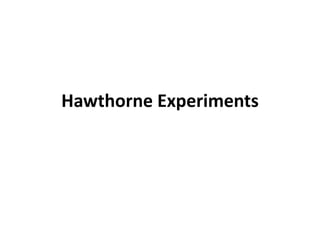
Hawthorne experiments
- 2. • The Human Relations Movement began with the Hawthorne Experiments. • They were conducted at Western Electrical Works in USA, b/w 1924-1932. • It was initially designed by Western Electric Industrial engineers
- 3. Four Parts of Hawthorne Studies / Experiments • Part I - Illumination Experiments (1924-27) • Part II - Relay Assembly Test Room Study (1927-1929) • Part III - Mass Interviewing Programme (1928- 1930) • Part IV - Bank Wiring Observation Room Experiment (1932)
- 4. Part I - Illumination Experiments (1924-27) • These experiments were performed to find out the effect of different levels of illumination (lighting) on productivity of labour. • The brightness of the light was increased and decreased to find out the effect on the productivity of the test group. Surprisingly, the productivity increased even when the level of illumination was decreased. • It was concluded that factors other than light were also important.
- 5. Part II - Relay Assembly Test Room Study (1927-1929) • Under these test two small groups of six female telephone relay assemblers were selected. Each group was kept in separate rooms. From time to time, changes were made in working hours, rest periods, lunch breaks, etc. They were allowed to choose their own rest periods and to give suggestions. Output increased in both the control rooms. It was concluded that social relationship among workers, participation in decision-making, etc. had a greater effect on productivity than working conditions.
- 6. Part III - Mass Interviewing Programme (1928-1930) • 21,000 employees were interviewed over a period of three years to find out reasons for increased productivity. It was concluded that productivity can be increased if workers are allowed to talk freely about matters that are important to them.
- 7. Part IV - Bank Wiring Observation Room Experiment (1932) • A group of 14 male workers in the bank wiring room were placed under observation for six months. A worker's pay depended on the performance of the group as a whole. The researchers thought that the efficient workers would put pressure on the less efficient workers to complete the work. However, it was found that the group established its own standards of output, and social pressure was used to achieve the standards of output.
- 8. Conclusions of Hawthorne Studies / Experiments The conclusions derived from the Hawthorne Studies were as follows :- 1. The social and psychological factors are responsible for workers' productivity and job satisfaction. Only good physical working conditions are not enough to increase productivity. 2. The informal relations among workers influence the workers' behaviour and performance more than the formal relations in the organisation. 3. Employees will perform better if they are allowed to participate in decision-making affecting their interests.
- 9. Conclusions of Hawthorne Studies / Experiments 4. Employees will also work more efficiently, when they believe that the management is interested in their welfare. 5. When employees are treated with respect and dignity, their performance will improve. 6. Financial incentives alone cannot increase the performance. Social and Psychological needs must also be satisfied in order to increase productivity.
- 10. Conclusions of Hawthorne Studies / Experiments 9. Good communication between the superiors and subordinates can improve the relations and the productivity of the subordinates. 10. Special attention and freedom to express their views will improve the performance of the workers.
- 11. Criticism of Hawthorne Studies / Experiments The Hawthorne Experiments are mainly criticised on the following grounds :- 1. Lacks Validity 2. More Importance to Human Aspects 3. More Emphasis on Group Decision-making 4. Over Importance to Freedom of Workers
